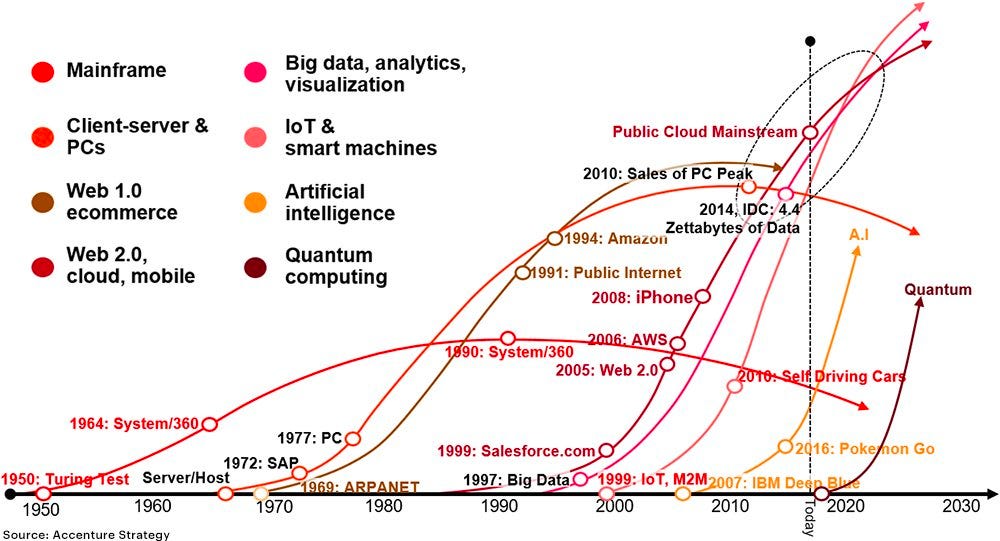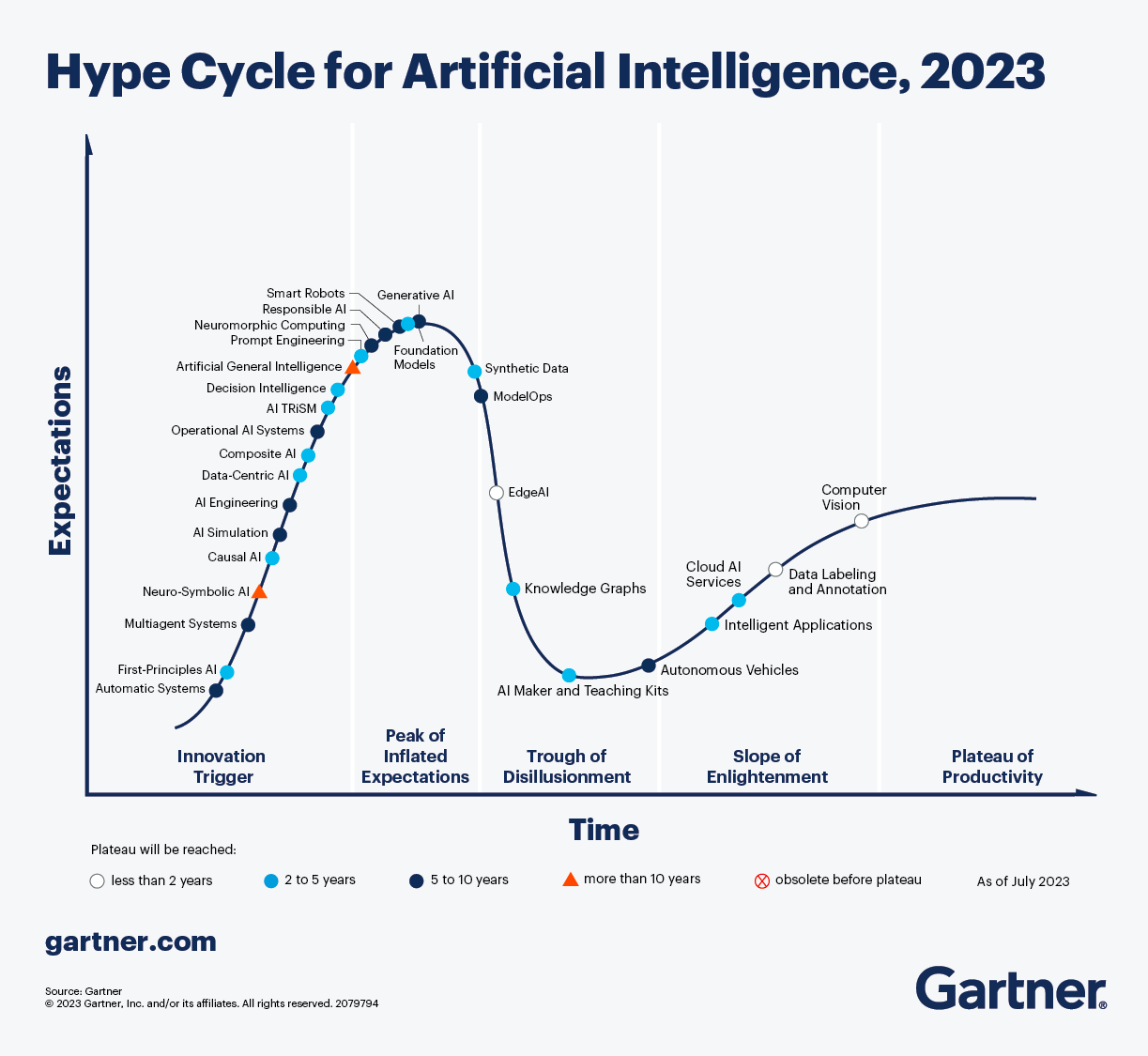AI in GTM & RevOps (4/4): When to invest?
Discover the dual perspectives on AI's future, its implications for humanity, and its evolving role in GTM & RevOps strategy.
Table of Contents
In 2017, Max Tegmark, a leading AI researcher, published “Life 3.0 Being Human in the Age of Artificial Intelligence”. In the book he describes different szenarios of the AI revolution. The optimist view supported by Larry Page or Sam Altman see AI as an enabler for humanity. Through AI humans might become gods. The pessimists view supported by Elon Musk and others see AI as a threat to enslave humanity.
It is a question about who will be in control (human or AI) and the degree of AI progress. This might sound like science fiction but the leading AI expert discuss this topics. Max Tegmark summarized the different outcomes in the graph below.
The dotted line is when we reach Artificial General Intelligence (AGI). To understand AGI, let’s revisit what we talked about so far. In part one of the blog, we talked about the rise of AI solutions and the different fields that are relevant for GTM & RevOps. In part two we looked at the requirement to deploy such AI solutions and the regulatory landscape - notably the EU AI pact. In part three, we discussed hypothetical AI solutions that are already on the market. All of those solutions are narrow AIs.
Narrow AI are all built for a very focused set of tasks: ChatBot, automations, or picture creation. Some AI features, like the updated ChatGPT 4 give you an illusion that you can do multiple activities at once (search the web and draw a picture) but it is still just a combination of different narrow AIs.
AGI only exists in movies so far, like HAL in 2001: A space Odyssey or R2-D2 in Star Wars. Researchers are unsure when we will reach AGI. The optimists say by 2050, pessimists say by 2100 and some say never.
The main reason why experts worry about AGI is that once an AI reaches AGI that it will not stop there. We humans have the physical constraints of our brain on how smart we can get. In other words, the processing power for humans is limited to the neural network of our brain.
An AGI does not have the problem. A potential AGI could access the computing power of super computers and all PCs in the world. That means, the moment an AGI reaches AGI it will directly reach a knowledge level that surpasses that of humanity. The big problem is that we can not even imagine what that would be due to the limitation of our own brains. That is the scary part.
Now, AGI is still science fiction but specialized AI is transforming the workspace.
Adaptation of new technology
The adaptation of new technology usually takes many years till it eventually reaches a plateau. Now, the commercial use of AI is a technology that gained quickly mass-market appeal.
The graph below compares it to other technologies.

They AI hype is real
Gartner, the company where you can buy a spot in a quadrant, also invented the Hype Cycle. It is a graphical representation of the lifecycle stages a technology goes through. From the initial development to its commercial availability and adoption, as well as its eventual decline and obsolescence.
You see the peak hype was generative AI. Think back to the launch of ChatGPT.

The understand of AI deployment and the hype cycle is good to provide some investment recommendation for AI tools. Let’s consider now short-term, mid-tern, and long-term AI investments
Short-term AI Investment
1. AI for Copy
The copy category is a mature AI use case. This included everything from writing blogs, prospecting email, or knowledge articles.
Now most tools assure that your data is private and not sharing the data to train the algorithm. With less security concerns the adaptation is getting wider.
2. Transcribing and translation
Meeting transcribing is very advanced and accurate by now. Most tools have a way of transcribing call. It has become a commodity by now. We see still a wider adaptation in North America and less in Europe. Here the issues are more about privacy that creates some resistance to record a call in the first place.
3. AI Chat bots
Conversational AIs are developmed and can trained to almost any use case. For example, in one weekend we build a GPT. We called him: “Albus - Your RevOps & GTM Consultant”. He is trained on unique RevOps data and combines the knowledge of the ChatGPT universe.
No surprise that businesses an build very sophistaced Chat bot based on their private data.
Mid-term AI investments
These AI tools are already promising for some businesses but maybe some could wait a bit longer with the investment
1. AI analytics
There are some interesting AI analytic use cases. They work well to provide answers to queries like show me the most successful lead sources within the last 12 months. They can be for now used for ad-hoc questions so that the management doesn’t need to ask the BI team.
However the main issue is that with BI questions the most work is spend in data preparation, cleaning, understanding the underlying motivation, and the real goal. This often makes the work more nuanced. The solution will be interesting when they support cleaning up data.
2. AI coaching
AI coaching is already working well for use cases like call assessments and live feedback. Another interesting usecase is for roleplay like mock calls. The benefit of this is that you are not burning real leads for training purposes.
The AI conversation will still have some more potential for improvement and we will see that more over the coming years. However, for an internal use case it can already be considered.
3. Connectivity between Tools and AI systems
A general limitation is that most AIs are narrow. They are becoming really good in one area but they lack the general knowledge and are well connected to other platforms.
For example, some AI’s have a narrow focus to improve copy for a blog but the same AI can not be used for chat support. One trend we will see in the future is a more integrated use cases. When you train one AI to manage your copy and that AI will be useable across different systems. At the moment, this would require training multiple AIs. Should this be a desired use case then waiting might be a good options.
Long-term AI investments
A few AI technologies and use cases still need to mature a longer time before they become solid investments.
1. AI live conversations
The technology to manage inbound and outbound calls is advanced but it is not perfect. For service use cases this might be earlier possible as nobody need to be convinced of a purchase.
The bigger issue will be rather the public perception on how they will accept an AI agent. Having an AI agent to book an appointment is one thing but have an AI agent to have a demonstration is a very different thing.
2. AI Avatars
Having an AI that replaces the full domain of one employee will still take some time. For example, if you want to have a BDR AI then this would require an AI that could:
Find leads and do account research
Personalize when there is not much public data
Manage inbound and outbound calls
Have meetings will clients
Meet the person on a conference
Now, some activities can be done within a narrow use case. And there are AI tools that attempt to do a few of the points. However, those system are not there yet. We can not recommend investing in any of those tools at this stage.
The future is AI
This is the end of our AI series. In doing the resaerch and testing for this AI series, it became evident to us that AI will change the future of work. At the same time, there are people that try to play it down or that don’t believe that AI won’t ever replace humans in certan tasks.
That type of resistance is normal. It happened with so many other technologies before. The risk here is to miss a major opportunity. That is why we recommend to be prepared for the AI future.
There is no way back anymore.
Revenue Wizards is a hands-on Revenue Operations Consultancy for growth companies focusing on efficiencies. We provide GTM & RevOps support with the goal of Revenue growth, GTM cost reduction, and Profitability. You can learn more about Revenue Wizards here.
Zhenya Bankouski is Co-Founder and Revenue Operations Partner. You can follow him on LinkedIn 🔔 where he posts regularly with practical advice on building efficient RevOps teams and truly data-driven organizations.
Haris Odobasic is Co-founder and Revenue Strategy Partner. Enjoys bringing strategy to life with RevOps.




